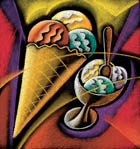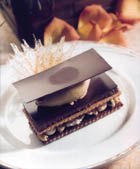
In most food categories, low-carb diets have morphed into diets based on the glycemic index. What does that mean for dessert lovers watching their weight? Very little, or in other words, very little desserts. Instead of revamping their dessert menus to reflect dieting practices, restaurateurs are miniaturizing desserts.
At the same time, restaurant patrons are becoming more aware of portion sizes, says Jenny Anderson, executive editor for Menu Clips, a newsletter distributed by Technomic Information Services (Chicago), a food industry intelligence provider.
Small plates, tapas and sample servings are nothing new to the foodservice industry and it makes sense that they have moved into the dessert category, says Kirstie Foster, manager of public relations at General Mills (Minneapolis).
For example, a cupcake trend is prevalent in health care foodservice as well as college and business cafeterias, reports Denise Salisbury, senior manager of culinary and bakery services for General Mills Bakeries & Foodservice. Innovations such as Novacart baking molds have made it convenient for chefs and foodservice workers to make small wonders with baked desserts. The attractive paper molds, designed to be a part of the packaging and eliminate metal baking pans, are available in a variety of shapes and sizes.
Cupcakes also add variety to a menu, as they can be finished with different icings or garnishes to make a very indulgent single serving, says Salisbury. A spread of mini carrot cake cupcakes prepared with Novacart paper reportedly were arranged to make a wedding cake for actress Sandra Bullock. “You can do a lot with cupcake displays,” says Salisbury. “It looks like you have more variety. When several small desserts like mini muffins, scones and cinnamon buns are arranged decoratively, they can conjure a sense of bountifulness.”
More importantly for consumers, small desserts allow indulgence. “When people want to indulge, they want the real thing; small desserts allow them to have what they want, but in a smaller portion. [Dieters] can ease back into carbohydrates with a little less guilt,” explains Foster. “The smaller desserts will still be decadent, and people will feel okay about that because the high-end indulgence satisfies an emotional need.”

Cake Love
“Comfort is a big dessert trend,” says Anderson. “People respond to retro or classic [desserts] that remind them of their childhood.” Cream puffs and funnel cakes are prime examples.The cream puff began as an Italian dessert and was once common to Old World and American fine dining cuisines. They also have been a staple at the Wisconsin State Fair since 1924 and still are served smothered in chocolate at Ristorante Milan (San Francisco).
The general popularity of the cream puff began to wane in the mid 1900s, however, because of the richness. One serving typically contains 500 calories and 40g-50g of fat. But with the help of Japanese aficionados like Beard-Papa’s (Muginoho Inc., Kita-ku, Osaka-shi, Japan) and A Choux Factory (Nomura Management Inc., New York), the cream puff is returning to the limelight. Both companies have opened several cream puff sanctuaries on the East Coast within the last year and a half. Inside one New York store, the walls recite a Japanese credo, “luscious tenderness and sweet compassion bring joy and contentment.”
Funnel cakes also are experiencing a nationwide reemergence. “Fried Twinkies® and candy bars, a trend popularized in England, has also trickled into a few independent U.S. places as a novelty,” states Anderson. “These desserts that we knew as kids have an emotional pull.”
Many restaurants have signature items that distinctly appeal to the child within. For example, The Amazon Grill (Houston) dessert menu presents a do-it-yourself interpretation of the Girl Scouts’ famous s’mores recipe using “a flaming habachi with marshmallows, graham crackers and chocolate bars embellished by animal crackers and coconut meringue.” Owner Michael J. Cordúa, who is of Nicaraguan heritage, also lists cotton candy on the menu at his contemporary Latin cafe.
Make-your-own s’mores and dessert fondues are examples of how diners are getting more involved in the preparation of their desserts. This trend adds an element of fun to dining and demonstrates how consumers are fond of customization, suggests Anderson.
The Classic Comeback
Other classic desserts are regaining popularity, but this time with a twist. “We see a resurgence of comfort desserts, like bread and rice puddings, that are really coming on strong,” says Salisbury. Bread pudding is a traditional dessert, but it becomes something new when it is served with crème anglaise and chocolate is substituted for the traditional vanilla custard. “The crème anglaise might be modified by adding liquor or a fruit-flavored infusion,” he says.Shakes once again are trendy in the limited-service segment. Restaurants like Sonic (Oklahoma City, Okla.), Jack-in-the-Box (San Diego, Calif.) and Ruby's Diner (Newport Beach, Calif.) have played on the retro idea of hand-scooped shakes for years, and the concept remains popular.
Many chefs are adding exotic sauces, fruits and flavors to dessert favorites or altering their presentation by using fancy dishes or ramekins. Sometimes they simply are serving apple pies shaped in a square instead of a wedge, or with phyllo dough instead of the traditional crust. In fact, some chefs opt to use phyllo dough because suppliers claim that phyllo dough is a low-fat, no-trans-fat, low-calorie, no-cholesterol alternative to prepared dough, puff pastries, refrigerated doughs and ready-made crusts.
“Fundamentally, desserts have not changed over the last five to 10 years. Presentation and garnishment have,” observes Salisbury. “Excitement and variety are generated by adding a new sauce or adding a new ingredient but keeping much of the fundamental dessert intact.”
Desserts prepared in the back-of-house are more versatile than those that are pre-assembled, says Salisbury. “[If you are serving pre-prepared apple pie] you can't incorporate new flavors into the crust. You can't add other fruits along with the apples. The clear benefit to preparing desserts back-of-house is flexibility and creativity,” says Salisbury. “It's easier to keep the menu fresh and varied for patrons.” Frozen, prepared desserts can also be quite limiting because they require large amounts of freezer or refrigerator space. The downsides to on-site preparation include the need for skilled labor and the use of bulky raw ingredients that can be inconsistent in quality and availability from week to week. But homemade ice creams and sorbets are proving to be a mainstay in restaurants because chefs enjoy the variety they add to menus when used in combination with sauces, brownies and pies.
The trickle-down principle also applies to desserts, says Anderson. What was once popular only in fine dining establishments is now also common at ordinary national restaurant chains. For example, molten chocolate cake, the tour de force of Jean-Georges Vongerichten (a star chef whose restaurant locations span from Hong Kong to Paris), is now one of the most popular desserts at Chili's Grill and Bar (Brinker International, Dallas).
Desserts also are losing their “afterdinner delicacy” persona. Premium hot chocolates and drinking chocolates have become afternoon treats at Starbucks (Seattle) and Au Bon Pan (Boston). And foodservice establishments like Ethel's Chocolates (Chicago) and Dessert Gallery Bakery and Cafe (Houston) have cropped up around the country. Both venues are dedicated to desserts only, and espouse the idea that dessert time is an anytime event.

Ethnic Inspirations
Ethnic desserts and flavor influences from Italian, Latin and Asian cuisines are changing mainstream restaurant dessert menus. “Chefs are experimenting with traditional ethnic desserts like flan, panicotta, tiramisu, cannoli and dessert crepes,” says Anderson.Sopapilla, made from small tortilla triangles with dusted sugar or cinnamon and drizzled honey, was traditionally a dessert found primarily on the menus of small, family-owned Latin restaurants like Ricardo’s Tavern House Restaurant (Hellertown, Penn.). But Anderson believes the inclusion of “Roasted Apple Sopapilla” at regional franchises like Buffalo’s Southwest Cafe (Marietta, Ga.) is evidence that it is fast becoming a crossover favorite. “Savory desserts are emerging in some areas,” says Anderson. Sweet and “spicy hot” is a combination that thrills some restaurant critics and disturbs others.
Nevertheless, mole, a spicy chocolate Mexican sauce originally used on poultry, is popping up on dessert menus, and Salisbury has witnessed chipotle pepper visited upon a fruited raspberry sauce and chocolate brownies.
Other examples include the wasabi ginger ice cream recently introduced at Cold Stone Creamery (Scottsdale, Ariz.) and the sour cream ice cream offered at Nacional 27 (Lettuce Entertain You, Chicago), a Latin-themed restaurant whose name refers to the 27 recognized Latin American countries.
Goat cheese strawberry tart is an interesting combination that has surfaced on menus recently. “The strong and astringent goat cheese with a lemon or other sour fruit evokes a zesty sensation, which is both fruity and familiar,” says Salisbury.
Some restaurants are combining the small serving concept of appetizers with their ethnic-influenced desserts. “P.F. Chang’s China Bistro (Scottsdale, Ariz.) has banana spring rolls, and executive chefs at Applebee’s International Inc. (Overland Park, Kan.) were inspired to offer Apple Chimicheesecake and Dulce de Leche cheesecake,” says Anderson.
Fruity Indulgence
“Fruit-based desserts are increasingly popular and offer a healthy 'halo' to a menu,” says Salisbury. “Fruit sorbets and gelatos are lower in calories and fat compared to ice creams and can still have a very satisfying and intense flavor.” Fruits are being grilled, roasted and marinated to add excitement to the palate. Mango, papaya, pineapple and coconut currently have become quite popular on dessert menus.“We have even seen fruit sushi with rich coconut rice, fresh berries, kiwi, papaya and black sesame seeds with bright raspberry and mango sauces for the dipping,” observes Bret A. Lynch, a corporate chef at Tree Top (Selah, Wash.).
“Desserts with fruits are an appealing way to increase fruit consumption,” says Anderson, referring to government efforts to promote greater fruit consumption. Many restaurants are using local or regional seasonal fruits, which convey the idea of fresher ingredients. Marie Callendar (Aliso Viejo, Calif.) often produces pies made with California fruits, which are sold when they are in season.
“Dried and evaporated fruit powders and pectin can be used as a clean and natural thickening agent,” offers Lynch. However, some fruits contain components that can negatively interact with the formula. Pineapple contains the enzyme bromelin, and papaya contains the enzyme papain. Both break down protein and, therefore, can prevent the gelatin from properly setting. “As a result, fresh pineapple or papaya can't be used in a Bavarian tart,” adds Lynch.
In desserts, the Mediterranean diet trend can be seen in the use of fig and date purees as fillings for tarts. Other health-conscious dessert examples include green tea-flavored ice cream and cream puffs.
Ironically, promoting desserts as being “healthier” can backfire. “We typically find that healthy high-end desserts aren't sustainable,” says Salisbury. When the dessert menu highlights something as a more healthy option, the consumer's memory usually carries with it the weight of previous healthy options. “Consumers remember the first low-fat desserts, and they remember they weren't good,” says Salisbury. “Organic or whole grain is as far as healthy items will find success in desserts.”
The right recipe can relieve the stress of a hard day's work or simply stir up memories of childhood sweets. Desserts are not designed to shed pounds, but years, so that we entertain and indulge the kid at heart.
Sidebar: The Entree Dessert
Dessert menus from quick-service to fine dining are spotlighting a new trend--developing ethnic entrees into fabulous desserts. Mexican entree transformations range from the ice cream truck favorite Choco Taco (Taco John's, Cheyenne, Wyo.; & Jimboy's Taco Express, Sacramento, Calif.) to an Apple Chimicheesecake (Applebee's, Overland Park, Kan.). Mexican specialties, the most common cuisine alteration, also include the Banana Burrito (Monterrey, Laurence, Ga.), Dulche de Leche, Pumpkin Brown Sugar and Chocolate Tamales (El Charro Cafe), and Oreo Nachos (Texas Steakhouse Child's Menu).Asian, Italian, Southern, American and fusion cuisines also are changing the flavor of entree favorites. Coconut Rice Pudding and 3 Fruit “Sushi” (Aureole NY, New York City) and Tempura Ice Cream (I Love Sushi, Bellevue, Wash.) replace seafood and vegetables in Asian favorites. Fine dining restaurants convert Italian ravioli and carpaccio into White Chocolate Ravioli (The Rattlesnake Club, Detroit, Mich.) and Pineapple Carpaccio (Aqua, Gary Danko Restaurant, San Francisco). A major staple in Southern cuisine also has taken a sweet turn in this area--Red Raspberry Grits are made from tapioca, raspberries and raspberry liqueur (Handke's Cuisine, Columbus, Ohio).
Even the American favorite, the loaded baked potato, has made a move onto the dessert menu. Ram Restaurant & Brewery (Lakewood, Wash.) offers the Ice Cream Potato made with Edy's® vanilla ice cream rolled in sweet cocoa, set atop hot fudge and garnished with whipped cream, toasted almonds and caramel sauce. The fusion influence is also seen on Chevy's Fresh Mex (Rocky Mount, N.C.) dessert menu with their Banana and Coconut “Spring Rolls.” These dessert spring rolls are made from fresh bananas, toasted coconut and pecans in a rich vanilla cream wrapped in a crispy spring roll and served with dulce de leche ice cream, chocolate and cajeta sauces.
--Maria Caranfa, Mintel's Menu Insights
Links
- Prepared Foods article - Type the following into the Linx search bar “The Chef
- Information about baked goods for foodservice
- A fact-based marketing research firm specializing in foodservice
- The Technomic Information Services website
- ComfortCake premium pound cakes
- Information about phyllo dough for desserts
- Supplier of dried and frozen fruit products and juice concentrates